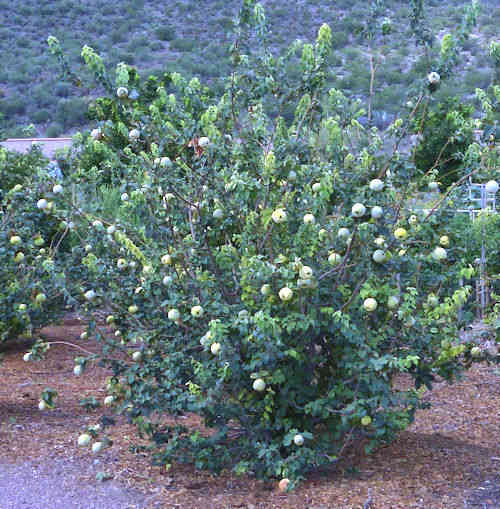Growing Quince:
Cydonia oblonga
Back to Fruit, Berries and Nuts
Botanical Overview
A member of the Rose family (Rosaceae), the Cydonia genus contains a single species, Cydonia oblonga: Quince. It is distantly related to other Rose family fruits, including apples and pears.
Description
Form:
Tree.
Lifespan:
30-50 productive years.
Leaf retention:
Deciduous.
Growth rate:
Slow to moderate.
Mature Size:
Cultivated trees are often 8-14' (2.4-4.3m) high and as wide.
Flowers:
Five narrow, white to pink petals from pink buds, 2" (5cm) wide.
Bloom:
Start of spring, after leaves develop.
Self-fruitful:
Yes, but yield increases with cross pollination from another quince tree within 30' (9m).
Years before fruiting:
3-5, depending on rootstock, 5-10 for maximum fruit bearing.
Fruit:
Bright yellow, shaped like a large apple or pear, similar to an apple on the inside.
The unripe fruit are covered with fine gray-white hairs which fall off as the fruit become
ripe. When first ripe, the fruit are still hard, and nearly all cultivars are astringent.
Months for fruit to ripen:
5-6 on the tree, with a strong fragrance when ripe.
Mature fruit snap easily from the branch.
If they are difficult to remove, they are not ripe. It has been recommended that the fruit
should be left on the tree as long as possible, to develop more flavor and fragrance, and not
harvested until just before the first frost arrives.
Storage after harvest:
Quince fruit continue to ripen, soften and become more fragrant after harvest. They can be
stored at room temperature for several weeks to soften, but are most often cooked instead.
Leaves:
Green, oval to broadly lance shaped, smooth edges, turn yellow in the fall.
Stems:
No thorns. The trunk has scaly bark that flakes off thin patches, displaying irregular bare
areas on a smooth surface.
Roots:
Quince are often grafted onto dwarfing or semi-dwarfing quince rootstock.
Cultivars of note:
'Orange' 300 chill hours, small-medium sized fruit,
orange-yellow flesh, rich flavor, astringent when ripe.
'Pineapple' 300 chill hours, medium-sized fruit,
white flesh with pineapple flavor, non-astringent but hard and tart when ripe.
'Smyrna' 300 chill hours, large fruit,
orange-yellow flesh, rich flavor, astringent when ripe.
Wildlife:
The flowers attract bees.
Toxic / Danger:
Leaves and seeds are mildly poisonous.
Origin:
Turkey and Iran.
Cultivation and Uses
USDA hardiness zones:
6-9.
Chill hours:
100-500 hours, depending on cultivar.
Heat tolerant:
Higher temperatures require slightly more water.
Drought tolerant:
This tree can endure one or two weeks without water after becoming established.
Sun:
Full sun is best to prevent diseases, but some part shade can be handled.
Planting:
Locate the tree in a location with full sun most of the day, in well draining, moderately
organic soil.
Soil:
Well draining, slightly moist and never completely dry, moderate organic content, pH 6.1-7.8
(slightly acidic to slightly alkaline). Alkaline soil results in iron deficiency.
Fertilize:
One a year, mid-winter, apply an organic fertilizer with micronutrients under the canopy but
1' away from the trunk. Avoid high nitrogen fertilizers. They will cause flower drop and
increase fire blight susceptibility.
Water after becoming established:
Deep water or basin irrigate once a week during
the growing and fruiting season. Deep water every two weeks to once a month, depending on
temperature, at other times. Insufficient water results in fruit drop.
Mulch:
Spread organic mulch under the canopy in late winter, 8" (21cm) away from the trunk, to
reduce moisture loss.
First Year Care:
Deep water using basin irrigation twice a week.
Prune:
After the last frost, or mid-winter, remove dead and damaged branches and remove any
branches too low to the ground.
Prune to shape but never remove more than one-third of the canopy.
The fruit develop on tips of the previous year's growth, so be careful what you cut.
The tree can be pruned to stay a certain height. Quince trees need less pruning with age.
Remove root suckers immediately.
Propagation:
Layering of branch tips into the ground, rooting softwood or hardwood cuttings, and grafting
cuttings onto quince rootstock. Seed do not grow true to their parents.
Pests:
Quince is susceptible to fire blight bacterial infection of open flowers during bloom,
especially when overwatered.
Uses:
Ornamental, edible fruit.
It is common to add some quince to apple pie for additional flavor.
On its own, quince is used for pies, jams, jellies, wine and cider. A small bowl of ripe
quince can be used as an air freshener because of its fragrance. Ungrafted trees can be
allowed to sucker and be grown as a hedge. Quince trees are now mainly grown to be used as
dwarfing rootstock for pears.
Comments
Do not confuse this plant with flowering ornamentals like Chinese Quince:
Pseudocydonia sinensis (formerly Cydonia sinensis, then Chaenomeles sinensis). Flowering
ornamentals do not fruit well.
Do you have additional information or a different experience for these plants that you would like to share? Email info@GardenOracle.com. All contributions are welcome and appreciated.
Do you have additional information or a different experience for these plants that you would like to share? Email info@GardenOracle.com. All contributions are welcome and appreciated.




Latest update: May, 2025
© 2008-2025 by GardenOracle.com

